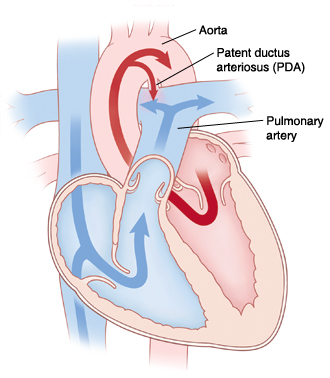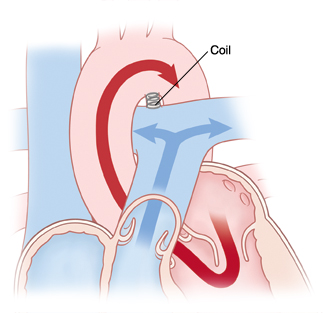When Your Child Has a Patent Ductus Arteriosus (PDA)
When Your Child Has a Patent Ductus Arteriosus (PDA)
Your child has been diagnosed with a patent ductus arteriosus (PDA). The ductus arteriosus is a normal structure in a fetus’ heart before birth. It’s a blood vessel that connects 2 arteries: the pulmonary artery and the aorta. The pulmonary artery carries blood from the heart to the lungs. The aorta carries blood from the heart to the body. Before birth, the ductus arteriosus allows blood from the right ventricle to bypass the lungs because the fetus gets oxygen from the mother. The ductus arteriosus normally closes shortly after birth once the baby breaths on its own. It’s called a PDA when it stays open (patent). A PDA can lead to worsening heart function over time. But it can be easily treated.
The ductus arteriosus is a normal structure in a baby’s heart before birth. It connects the aorta and the pulmonary artery. If it fails to close after birth, it’s called a PDA. |
A PDA can be closed with a coil using a cardiac catheterization procedure. |
Why is a PDA a problem?
With a PDA, blood flows from the aorta through the PDA into the pulmonary artery. This causes increased blood flow to the lungs. If the PDA is large, too much blood goes to the lungs and recirculates to the left ventricle. This can cause fluid buildup in the lungs (pulmonary edema). Then the baby has a hard time breathing and feeding.
In severe cases, the combination of the increased blood flow to the lungs and work to the left ventricle can lead to congestive heart failure (CHF). This is a condition in which the heart no longer pumps blood well.
What are the symptoms of a patent ductus arteriosus?
Most children with a small PDA have no symptoms. Children with a large PDA are more likely to have symptoms. These can include:
Trouble breathing or rapid breathing
Trouble feeding
Slow weight gain
Frequent respiratory infections
Heart murmur
How is a patent ductus arteriosus diagnosed?
Heart problems in children are usually diagnosed and treated by a pediatric cardiologist. This is a doctor with special training to diagnose and treat heart problems in children. Signs of a heart problem will be checked for during a physical exam. To confirm a diagnosis or learn more about a possible heart problem, the doctor may order several tests. These include:
Chest X-ray. X-rays are used to take a picture of the heart and lungs.
Electrocardiogram (ECG). This test records the electrical activity of the heart.
Echocardiogram. Sound waves are used to create a picture of the heart and look for structural defects and other problems.
How is a patent ductus arteriosus treated?
A PDA may close on its own, without treatment. If it doesn’t, treatment choices are medicine, cardiac catheterization, or surgery. Your child’s cardiologist will evaluate your child’s heart and discuss the best treatment choice with you.
Medicine. Medicine may be the first treatment choice for premature infants. These medicines are usually given by IV.
Cardiac catheterization. A thin, flexible tube (catheter) is put into a blood vessel. It’s used to guide a coil or closing device into the heart to close the PDA. The catheter is removed when the coil or device is in place.
Surgery. The surgeon may use one of two techniques. In the first (thoracotomy), an incision may be made through the chest between the ribs to reach the PDA. In the second technique, video-assisted thoracoscopic surgery (VATS), very small incisions are made in the chest. A special scope that has a camera on the end is used to guide the surgeon to the PDA. The PDA is clipped or tied off. It may or may not be divided. If it’s divided, the open ends are closed with sutures.
Risks and complications of surgery or cardiac catheterization
Risks and possible complications include:
Reaction to contrast dye (only with cardiac catheterization)
Reaction to sedative or anesthesia
Incomplete closure of the PDA
Infection
Bleeding
Abnormal heart rhythm (arrhythmia)
Injury to the heart or a blood vessel
Injury to nerves
When to call the doctor
After surgery or a cardiac catheterization procedure, call the doctor right away if your child has any of the following:
Increased redness, draining, swelling, or bleeding at the incision or insertion site
Fever 100.4°F (38°C) or higher
Trouble feeding
Tiredness
Shortness of breath
Cough that won’t go away
Prolonged nausea or vomiting
Irregular heartbeat
Passing out
What are the long-term concerns?
After repair of a PDA, symptoms related to the defect should go away. Your child should have a heart that works normally.
Follow-up visits with the doctor may be needed for 6 months after treatment.
Your child may need to take antibiotics for about 6 months before having any surgery or dental work after PDA closure. This is to prevent infection of the inside lining of the heart or valves. This infection is called infective endocarditis. Antibiotics should be taken as directed by the cardiologist.
Updated:
August 29, 2018
Sources:
Clinical manifestations and diagnosis of patent ductus arteriosus in term infants, children and adults, Up To Date, Management of patend ductus arteriosus, Up To Date
Reviewed By:
Ayden, Scott, MD,Bass, Pat F. III, MD, MPH,Image reviewed by StayWell medical illustration team.

